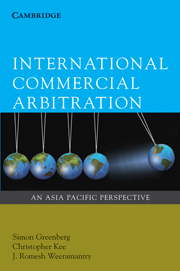Book contents
- Frontmatter
- Contents
- Foreword
- Preface
- Table of Cases
- Table of Statutes
- 1 Introduction to international arbitration and its place in the Asia-Pacific
- 2 Law governing the arbitration and role of the seat
- 3 Applicable substantive law
- 4 Arbitration agreement
- 5 Arbitral jurisdiction
- 6 The arbitral tribunal
- 7 Procedure and evidence
- 8 The award
- 9 The award
- 10 Investment treaty arbitration
- Appendix 1 Asia-Pacific arbitral institutions at a glance
- Appendix 2 Selected arbitral institutions
- Appendix 3 List of UNCITRAL Model Law countries
- Appendix 4 List of parties to the New York Convention 1958
- Appendix 5 Selected list of Asia-Pacific arbitration legislation and instruments
- Glossary
- Index
1 - Introduction to international arbitration and its place in the Asia-Pacific
Published online by Cambridge University Press: 05 June 2012
- Frontmatter
- Contents
- Foreword
- Preface
- Table of Cases
- Table of Statutes
- 1 Introduction to international arbitration and its place in the Asia-Pacific
- 2 Law governing the arbitration and role of the seat
- 3 Applicable substantive law
- 4 Arbitration agreement
- 5 Arbitral jurisdiction
- 6 The arbitral tribunal
- 7 Procedure and evidence
- 8 The award
- 9 The award
- 10 Investment treaty arbitration
- Appendix 1 Asia-Pacific arbitral institutions at a glance
- Appendix 2 Selected arbitral institutions
- Appendix 3 List of UNCITRAL Model Law countries
- Appendix 4 List of parties to the New York Convention 1958
- Appendix 5 Selected list of Asia-Pacific arbitration legislation and instruments
- Glossary
- Index
Summary
Introduction and definition of arbitration
Over the past 20–30 years, international arbitration has become by far the most popular mechanism for resolving international commercial disputes in the Asia-Pacific and globally. International arbitration is exceptionally effective because of its flexibility, neutrality, finality, and enforceability. It is flexible because parties are accorded enormous freedom to choose the manner in which their dispute is decided. They can, for example, agree on the seat of arbitration, the identity of the arbitrators, the applicable law, the number of written briefs (if any), the number of oral hearings or meetings (if any), and whether there will be expert or factual evidence. The neutrality of arbitration principally relates to separating the dispute resolution mechanism from any of the parties' countries and from any political interference. Parties can, for example, select a seat of arbitration, applicable law and arbitrators from a country that is neutral with respect to all parties. Arbitration is final because domestic legal systems generally do not permit any appeal from arbitrators' awards, and allow only very limited review of such awards on procedural grounds. Arbitration is enforceable thanks to its recognition in virtually all domestic laws and thanks to several international treaties. Arbitral awards may be enforced using the enforcement mechanisms of state courts in most countries throughout the world. As we will see, the study of international arbitration is exciting, innovative, creative, and yet sometimes complex.
- Type
- Chapter
- Information
- International Commercial ArbitrationAn Asia-Pacific Perspective, pp. 1 - 53Publisher: Cambridge University PressPrint publication year: 2010

